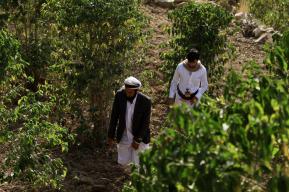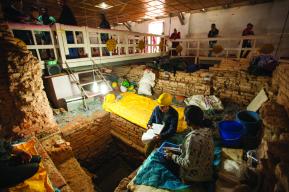The panoramic view of the historical buildings located in Al-Qassimi neighborhood used to be one of the most recognized landscapes of the Old City of Sana'a. This postcard scene has been affected during the Yemeni conflict, which destroyed several historical buildings, took many of their lives, and displaced many others. Suhira, a widowed teacher and mother of two, had spent 12 years living in one of those flagship houses before she was forced to leave her home after it collapsed in June 2015. The thought of her house occupied her mind ever since. Suhira has determinedly spent the past years knocking on every door trying to rebuild what was once her most important place in the world.

The conflict forced Suhira out of the house after most of its parts collapsed, and its furniture was destroyed. She rented a small apartment to shelter her two children. The monthly rent made her life even more difficult as she had to cover their daily needs since her husband's death in 2012. Suhira recalls the difficult situations she lived outside her home: "The most difficult moment was when I started collecting the monthly rent and was barely able to make it available for the landlord." She was very worried about the future of her two children. "Who would stand with them while they are orphans, and their mom does not have any adequate resources."
The conservation of her 100-year old tower house worsened every year. She inherited this house from her mother in exchange for her share of her father's inheritance in 1997.

The Sana'a tower house originates in the ancient South Arabian peninsula and counts as the most complex in Yemen's highland in terms of variety, décor, and building techniques, reflecting different regional influences and historical layers impacting Sana'a.
The multiple challenges Suhira faced did not hold back her determination to save her father's house. They have even strengthened her resilience to recover it with all the original architectural details. In February 2017, she decided to get rid of the burden of living in a rented apartment and heal the trauma her family faced by rebuilding her own family's house. She only had a small amount of savings and thus decided to sell her golden jewelry.

As part of the UNESCO's Heritage Emergency Fund (100.000 USD) for Al-Qassimi, implemented in partnership with the Social Fund for Development, in coordination with the General Organization for the Preservation of Historic Cities in Yemen (GOPHCY), her house was selected among the most damaged buildings in need of urgent repairs within Al-Qasimi neighborhood. The house's selection resulted from a comprehensive damage assessment and rehabilitation plans under the Cash for Work project, which is generously funded by the European Union (12 M. USD) and implemented by UNESCO. Suhira notes, "I was surprised and cried, and I felt that God heard my calls and released my family from our sacrifice." The emergency interventions allowed for urgent stabilization of the second and third floors, which was essential to ensure the historical building's integrity. Additional works were carried out under the EU-funded project based on cash for work modality, allowing youth from the local community to gain daily incomes from their contribution to the rehabilitation works.
Suhira emphasizes that the interventions have fulfilled her dream and those of her children returning to their house, restoring its original shape and character in coherence with the old traditional specifications. "I feel safer, more stable with my children living in their own home. This is our kingdom, and they will never abandon it."

This intervention was supported by the UNESCO Heritage Emergency Fund. We wish to thank its donors: the Qatar Fund for Development, the Kingdom of Norway, the Government of Canada, ANA Holdings INC., the Principality of Monaco, the Kingdom of the Netherlands, the Republic of Estonia, the Grand Duchy of Luxembourg, the Slovak Republic, the Principality of Andorra, and the Republic of Serbia. It has also benefitted from the support of the project Cash for Work: Promoting Livelihood Opportunities for Urban Youth in Yemen,” generously funded by the European Union.










